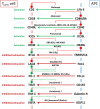The Emerging Jamboree of Transformative Therapies for Autoimmune Diseases
- PMID: 32296421
- PMCID: PMC7137386
- DOI: 10.3389/fimmu.2020.00472
The Emerging Jamboree of Transformative Therapies for Autoimmune Diseases
Abstract
Standard treatments for autoimmune and autoinflammatory disorders rely mainly on immunosuppression. These are predominantly symptomatic remedies that do not affect the root cause of the disease and are associated with multiple side effects. Immunotherapies are being developed during the last decades as more specific and safer alternatives to small molecules with broad immunosuppressive activity, but they still do not distinguish between disease-causing and protective cell targets and thus, they still have considerable risks of increasing susceptibility to infections and/or malignancy. Antigen-specific approaches inducing immune tolerance represent an emerging trend carrying the potential to be curative without inducing broad immunosuppression. These therapies are based on antigenic epitopes derived from the same proteins that are targeted by the autoreactive T and B cells, and which are administered to patients together with precise instructions to induce regulatory responses capable to restore homeostasis. They are not personalized medicines, and they do not need to be. They are precision therapies exquisitely targeting the disease-causing cells that drive pathology in defined patient populations. Immune tolerance approaches are truly transformative options for people suffering from autoimmune diseases.
Keywords: autoimmunity; biologics; immune checkpoints; immune tolerance; immunotherapy; nanomedicine; precision medicine; safety.
Copyright © 2020 Carballido, Regairaz, Rauld, Raad, Picard and Kammüller.
Figures



References
Publication types
MeSH terms
LinkOut - more resources
Full Text Sources
Medical

